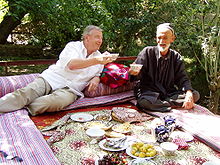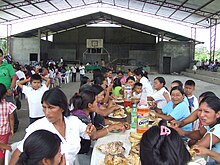Table community
A table community is a community that is formed by participating in a meal. In a broader sense, “table community” can also be understood figuratively and includes people who organize their food together. For example, in Swiss law , the "consolidated concubinage " described as "living, table and bed community".
Sociological consideration
The family crystallized earlier in the form of the table community with shared meals as the central focus of the life of several generations . Due to the change in the image of the family in industrialized countries, however, this fact is no longer generally applicable. The common ground forms a unity of time and space and the people see themselves as a community of like-minded people, with the same habits and customs and traditions .
Historical table communities
The daily men's meals, known as Syssitien in the 1st and 2nd centuries , were table communities in the ancient Doric states of Greece , especially Sparta , where they were also called Phiditien . In addition to eating, these table communities had a social, political and educational function. All participants were obliged to maintain confidentiality , younger members gained experience and learned norms , values and ways of life .
The Swiss term Uerte , for example, denotes a table community in a restaurant and thus denotes the equal sharing of the bill (bill). In Innviertel were carousing young men's groups, the u. a. were characterized by a common meal.
The on sailing ships ride- sailors are in baking properties divided by six to ten men. You will be assigned a seat for the journey where you can form a table community, this is headed by a baker.
Luther's table groups and dinners
The reformer Martin Luther (1483–1546) was known for his fine dining. For him it was true: "Guest meals should serve to make people happier and to refresh the mind after sadness". Even in his day it became clear that these had an important social function, his guest meals were exclusive. Anyone who had received an invitation to the Lutheran Table Congregation, such as the composer Georg Forster , belonged to the elite . Many depictions in the Lutherhaus in Wittenberg show Luther with his wife and depict him in the circle of his family and especially eating at home.
Religious table groups
North Germanic table communities
A well-known old Scandinavian festival in the North Germanic religion was the Blót , a cult activity consecrated to the gods in the pre-Christian times . The communion with one another and with the gods was strengthened through the associated feast.
New Testament table communities

The Agape was in the early Christian table fellowship a synonym for the Eucharist and was celebrated with rich and poor people. On this occasion, the Christians brought food and drinks with them, which were blessed and consumed together. The agape - or love feast - had a religious aspect and at the same time served a charitable purpose. The table communities of the New Testament are linked with motifs of togetherness, human solidarity, friendship , hospitality , trust, respect and respect.
A table community that is important from a Christian perspective is that of the "Last Supper". Jesus celebrated the prescribed ritual meal with his disciples on the Seder evening before the Jewish Passover . During or after this meal, Jesus established the Eucharist as a sign of his abiding presence in the community, and the following day he was crucified . In the New Testament the evangelists and the apostle Paul portray the meal differently ( Mt 26.17–29 EU ; Mk 14.12–26 EU ; Lk 22.14–20 EU ; Joh 13.2–4 EU ; 1 Cor 11.23-26 EU ). The Gospels describe the last table fellowship of Jesus with different terms, in Matthew and Luke it is called "meal", John calls it "farewell meal". In his first letter to the Corinthians, Paul urges the right celebration of the Lord's Supper and reminds us of Jesus' Last Supper. The texts became the basis for the words of institution in the Christian liturgy.
Islamic festivals

The focus of all religious holidays of Islam are the common round tables and family table communities. The festival of breaking the fast is an example of this. This festival celebrates the end of Ramadan , the month-long fasting period. It is characterized by common prayer, family members and acquaintances come together throughout the day and take part in meals together. Both family members and guests are given a particularly warm welcome.
In the everyday life of Muslims , eating meals together is an important social function. As hospitality is an important religious element in the Islamic world , it is considered the top priority in the life of a Muslim .
Table communities in art
In Rhineland-Palatinate, artists networked the entire country into a table community with the art project Tischtransaction .
literature
- Christof Landmesser: Calling disciples and devotion to God. (= Scientific investigation on the New Testament. 133). Mohr Siebeck, 2001, ISBN 3-16-147417-1 .
- Otfried Hofius : Jesus' table fellowship with sinners , Calwer Verlag, 1967
- Otfried Hofius: New Testament Studies. (= Scientific research on the New Testament. 132). Mohr Siebeck, 2000, ISBN 3-16-147416-3 .
- Veronika Beck, Burga Gripekoven, Monika Rautenberg (eds.): Table stories. B. Kühlen Verlag, Mönchengladbach 2014, ISBN 978-3-87448-392-6 .
- Albert O. Hirschman : table community. Between the public and the private sphere , Passagen Verlag, Vienna 1997, ISBN 3-85165-267-3
- Ulrich Berner: Commensality. In: Hubert Cancik , Burkhard Gladigow , Karl-Heinz Kohl (eds.): Handbook of basic concepts for religious studies . Volume 3: Law - Cult. W. Kohlhammer, Stuttgart, Berlin, Cologne 1993, ISBN 3-17-009555-2 , pp. 390-392 (preview) .
Individual evidence
- ↑ Spektrum.de Lexicon of nutrition, table community
- ↑ BGE 138 III 97. In: Homepage of the Federal Court. January 18, 2012, accessed October 26, 2015 .
- ↑ Alexander Deichsel : Sociology - An Introduction. Lexikothek, Gütersloh 1983, pp. 25 and 34.
- ↑ Herders Conversations-Lexikon: Phiditien [1]
- ^ Student speech , Tübingen ; developed by the students Carmen Bohner, Jakob Fuchs, Stefanie Fritz, Friederike Heinzmann and Pastor Katharina Dolmetsch-Heyduck; held by Carmen Bohner and Friederike Heinzmann, Tübingen, October 26, 2011 [2]
- ↑ Eckhard J. Schnabel: Pages Original Christian Mission. R. Brockhaus Verlag, 2002 [3]
- ^ Bertram Stubenrauch : Eucharist. In: Georg Gänswein , Martin Lohmann (ed.): Catholic - first-hand knowledge. CMZ-Verlag Winrich C.-W. Clasen, Rheinbach 2010, ISBN 978-3-87062-116-2 .
- ↑ Art project table transaction [4]
Web links
- In Form, Germany's initiative for healthy eating and more exercise: table communities
- Eckhard Nagel, Florian Jeserich, Felix Reuter, Andrea Rot: No closed society - the table community in the Jesuan tradition means mutual acceptance and anticipation. In: Zeitzeichen-Evangelical Commentaries on Religion and Society. accessed on September 2, 2014
- Lebensreise.info: Holy Places, The Dining Table


